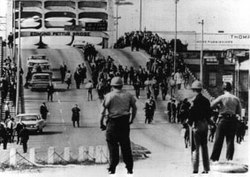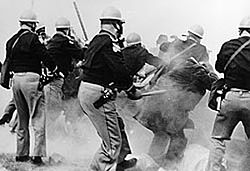Selma, Alabama
Selma is a city in and the county seat of Dallas County, Alabama, United States, located on the banks of the Alabama River. The population was 17,971 at the 2020 census.[3] The city is best known for the Selma to Montgomery marches, three civil rights marches that began in the city.
|
| |
 Location in Dallas County and the state of Alabama | |
| Coordinates: 32°24′59″N 87°1′29″W / 32.41639°N 87.02472°WCoordinates: 32°24′59″N 87°1′29″W / 32.41639°N 87.02472°W[1] | |
| Country | United States |
| State | Alabama |
| County | Dallas |
| Founded | 1815 |
| Incorporated | 1820 |
| Government | |
| • Type | Mayor–council |
| Area | |
| • Total | 14.40 sq mi (37.30 km2) |
| • Land | 13.81 sq mi (35.77 km2) |
| • Water | 0.59 sq mi (1.54 km2) |
| Elevation | 135 ft (41 m) |
| Population | |
| • Total | 17,971 |
| • Density | 1,301.40/sq mi (502.46/km2) |
| Time zone | UTC−6 (CST) |
| • Summer (DST) | UTC−5 (CDT) |
| ZIP Codes | 36701-36703 |
| FIPS code | 01-69120 [1] |
| GNIS ID | 163940 [1] |
| Website | selma-al.gov |
Notable residents
- Jeff Sessions, U.S. Senator
Selma, Alabama Media
Union General James H. Wilson
Confederate General Nathan B. Forrest
St. Paul's Episcopal Church burned following the Battle of Selma and was rebuilt in 1871.
Portion of the corten steel monument at the EJI's National Memorial for Peace and Justice memorializing the Black individuals lynched in Dallas County, Alabama.
Brown Chapel A.M.E. Church in Selma. A gathering place for meetings and a starting point for the Selma to Montgomery civil rights marches of 1965, it has been designated as a National Historic Landmark.
References
- ↑ 1.0 1.1 1.2 1.3 "Selma, Alabama". Geographic Names Information System. United States Geological Survey.
- ↑ "2020 U.S. Gazetteer Files". United States Census Bureau. Retrieved October 29, 2021.
- ↑ 3.0 3.1 "Selma city, Alabama". United States Census Bureau. Retrieved September 5, 2023.
| Wikimedia Commons has media related to Lua error in Module:Commons_link at line 62: attempt to index field 'wikibase' (a nil value).. |











